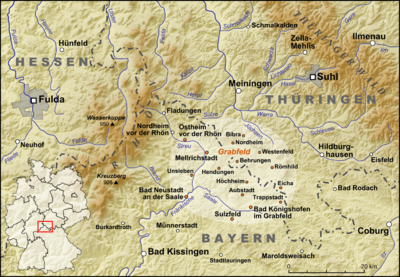Grave field table
| Grave field table | ||
|---|---|---|
|
Spoken in |
Bavaria , Thuringia | |
| Linguistic classification |
|
|
Grabfeldisch is an East Franconian dialect that is mainly spoken in the landscape around Bad Königshofen and Mellrichstadt in Bavaria and in the Römhild area south of Meiningen in Thuringia . In the Hessian Rhön in the direction of Fulda , the Grabfeldische flows into the East Hessian and in the Thuringian foothills of the Rhön near Kaltensundheim into the Hennebergische .
history

past it was roughly the area of the map, today the area marked in light
The dialect area corresponding to the core of an early medieval Gaugrafschaft, the grapfeld orientalis , which documented and 813 of the Popp Onen was dominated. At the beginning of the High Middle Ages, the Lords of Wildberg ruled here, who named themselves after the Wildberg Castle in the Haßbergen . As an allod of the Burgraviate of Würzburg , a large part of the land came into the possession of the County of Henneberg in 1157 , the Botenlauben line in 1190, and the Aschach -Römhild line in 1274 .
This lost the unity of the old county. The area was divided among the high medieval regional powers who drew their borders through the country. The Henneberg, today Lower Franconian parts of the country were gradually acquired from 1353 by the Hochstift Würzburg . The court of Römhild came to the Counts of Mansfeld in 1548 , from them to the care of Coburg in 1555 and thus to the Electorate of Saxony . As the Ernestine Duchy of Saxony-Römhild , the Römhild grave field achieved a certain degree of independence for another 30 years from 1680 to 1710, until it became part of the Duchy of Saxony-Meiningen .
Ostheim vor der Rhön came to Saxony-Coburg-Eisenach in 1572 , was an office of the Grand Duchy of Saxony-Weimar-Eisenach from 1741 and came as an exclave to the newly founded state of Thuringia in 1920 . In 1945, Ostheim was assigned to the Free State of Bavaria as part of the American occupation zone and was under Bavarian administration as a Thuringian enclave.
From 1949 to 1990 the inner-German state border ran right through the grave field. Today this landscape belongs partly to the administrative district of Lower Franconia in the Free State of Bavaria and partly to the Free State of Thuringia . The old Main Franconian dialect was only slightly reshaped despite the many changes of rule and is still a unifying characteristic today.
See also
See also: Mainfränkisch